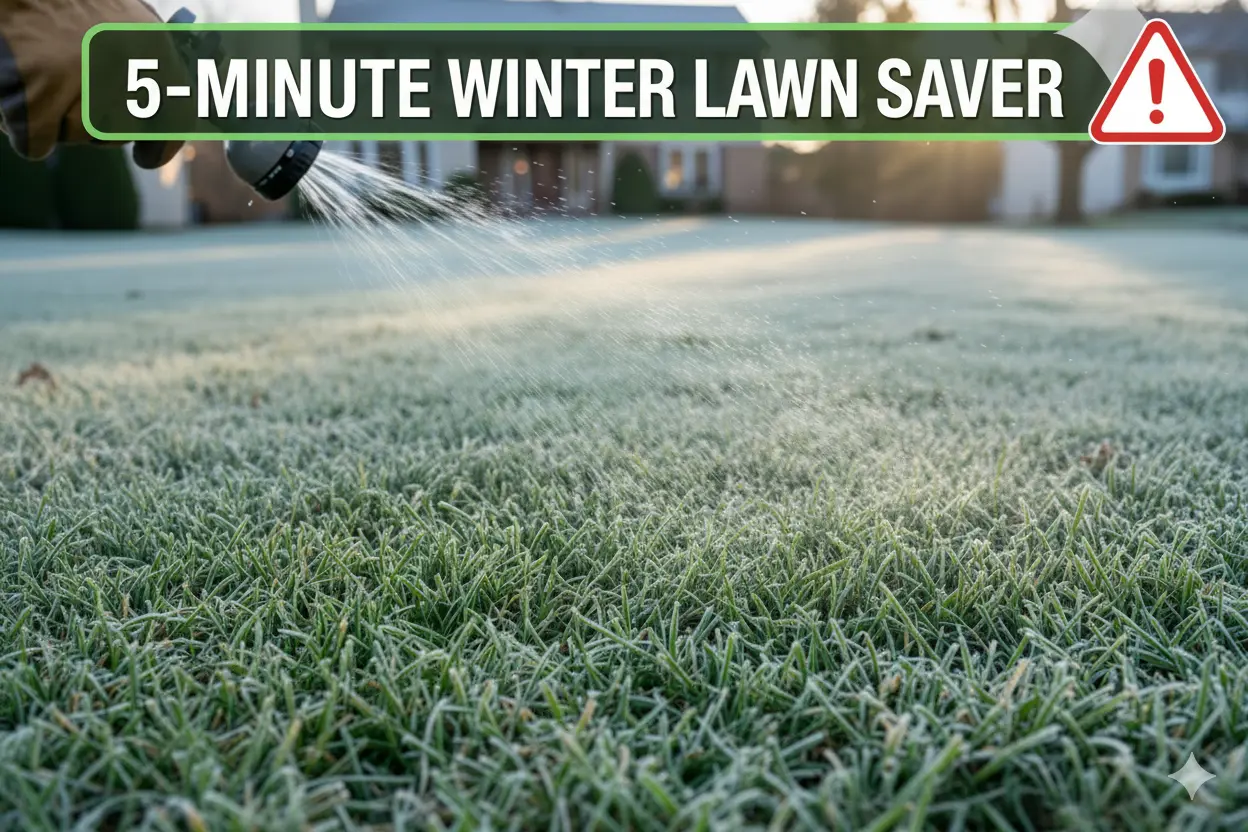WARNING: The 5-Minute Task That Saved Thousands of Lawns From Winter Burn

As the chill of winter approaches, many homeowners assume their lawn care duties are over until spring. This dangerous oversight, however, can lead to a devastating phenomenon known as winter burn. This condition, where grass turns brittle, brown, and lifeless, affects thousands of lawns across the United States every year. But what if we told you there’s a simple, 5-minute task that can act as a crucial shield against this seasonal scourge? Experts are now revealing a last-minute intervention that has proven to be a game-changer for countless homeowners. Don’t let your lush green lawn become another victim – read on to discover this vital winter prep secret.
What Exactly Is Winter Burn and Why Is It So Dangerous?
Winter burn isn’t just your grass going dormant; it’s often a sign of severe dehydration and damage during the colder months. When temperatures drop, and especially when harsh winds blow, the grass blades continue to lose moisture. If the ground is frozen, the roots cannot absorb water to replenish what’s lost, leading to desiccation. This process often accelerates on sunny winter days, as the sun’s warmth can slightly thaw the top layer of soil, prompting the grass to try and draw water, only to find the deeper roots still locked in ice.
The danger lies in its long-term impact. A lawn severely affected by winter burn will struggle to recover in spring, often requiring extensive (and expensive) reseeding or even full sod replacement. It also makes your lawn more susceptible to diseases and weed infestations.
Signs Your Lawn is at Risk for Winter Burn
- Dry, Brittle Feel: The grass feels crunchy underfoot, even if there’s no frost.
- Brown or Tan Patches: Unlike uniform dormancy, winter burn often appears in irregular, straw-like patches.
- Persistent Frost: Areas that retain frost for extended periods are more vulnerable.
- Exposure: Lawns on south-facing slopes or those exposed to strong, cold winds are at higher risk.
The Secret 5-Minute Task: The Late-Season Deep Water
The simple, yet often overlooked, task that can save your lawn from winter burn is a late-season deep watering. This isn’t just any watering; it’s a strategic application of moisture just before the ground freezes solid for the winter.
Why a Late-Season Deep Water Works Wonders
- Hydrates Roots: A deep watering ensures that the grass roots have a substantial reservoir of moisture to draw upon throughout the winter, even when the topsoil freezes intermittently.
- Insulates Soil: Water holds heat better than dry soil. A well-hydrated lawn can maintain a slightly warmer soil temperature, offering a minor insulating effect against extreme cold.
- Prevents Desiccation: It acts as a protective barrier, reducing the rate at which moisture evaporates from the grass blades, thus preventing them from drying out.
- Boosts Winter Hardiness: A properly hydrated lawn is a healthier lawn. Healthier grass is more resilient and better equipped to withstand the stresses of winter.
How to Perform This Crucial 5-Minute Task Correctly
Executing this deep watering correctly is key to its effectiveness. It’s not just about turning on the sprinkler.
Step-by-Step Guide:
- Timing is Everything: Aim for a day when the temperature is above 40°F (4°C) but before the ground is expected to freeze solid for the season. Often, this falls in late fall or early winter (November to early December in many northern regions, or even later in milder climates). Choose a day when there’s no immediate threat of a hard freeze immediately after watering, as this could lead to ice formation on the grass blades.
- Go Deep: The goal is to moisten the soil to a depth of 4-6 inches. This usually means watering for a longer duration than your typical summer watering sessions. Use a screwdriver or a soil probe to check the depth. If it penetrates easily to 4-6 inches, you’ve watered enough.
- Use a Sprinkler: A traditional sprinkler or a soaker hose is ideal for even distribution. Avoid hand-watering, which often leads to uneven saturation.
- Avoid Waterlogging: While you want deep saturation, you don’t want standing water. If water starts to pool, stop for a bit, let it soak in, and then resume. Over-watering can lead to root rot.
- Focus on High-Risk Areas: Pay extra attention to slopes, elevated areas, and parts of your lawn exposed to strong winds, as these areas dry out faster.
People Also Ask (PAA): Your Top Winter Lawn Questions Answered
Many homeowners have similar questions about winter lawn care. Here are some of the most common ones:
Q1: Is it bad to water your lawn in the winter?
No, it’s not bad; in fact, it can be crucial. While regular watering stops once the grass goes dormant, a strategic late-season deep watering just before a hard freeze is highly beneficial. However, avoid watering when the ground is already frozen solid or when temperatures are below freezing, as this can create ice hazards and won’t be effective.
Q2: How do you protect your lawn from winter damage?
Beyond the late-season deep watering, you can:
- Fertilize in Fall: Apply a “winterizer” fertilizer in late fall to strengthen roots.
- Mow One Last Time: Keep the grass slightly longer (2.5-3 inches) for the last mow, which helps insulate the crown.
- Clear Debris: Remove leaves and other debris that can smother the grass and promote disease.
- Avoid Foot Traffic: Minimize walking on frozen grass, as it can damage the brittle blades.
Q3: How do you bring a dead lawn back to life after winter?
If your lawn suffered winter burn, assess the damage in spring. For minor browning, a good spring fertilization and consistent watering may be enough. For severely damaged patches, you might need to rake out the dead grass, amend the soil, and reseed or lay new sod. Aeration can also help rejuvenate compacted soil.
Q4: What temperature is too cold to water grass?
Generally, avoid watering when the air temperature is consistently below 32°F (0°C), especially if the ground is already frozen or expected to freeze immediately after. The goal of late-season watering is to allow the water to soak into the soil, not to create a sheet of ice on your lawn.
Don’t Let Winter Burn Steal Your Spring Green
Ignoring your lawn in the late fall or early winter is a common mistake that thousands of homeowners regret come spring. This 5-minute deep watering task is a small investment of time that pays off immensely, safeguarding your lawn against the harsh realities of winter burn. By providing your grass with a final, generous drink before the deep freeze sets in, you’re not just preventing damage – you’re setting the stage for a vibrant, healthy, and envy-inducing green lawn next spring. Make this quick task a part of your winter prep routine, and you’ll be amazed at the difference it makes!
To keep your yard fit and beautiful all year round and to discover more invaluable tips, visit our Fit for Yard homepage and stay connected with our latest gardening news and updates.






